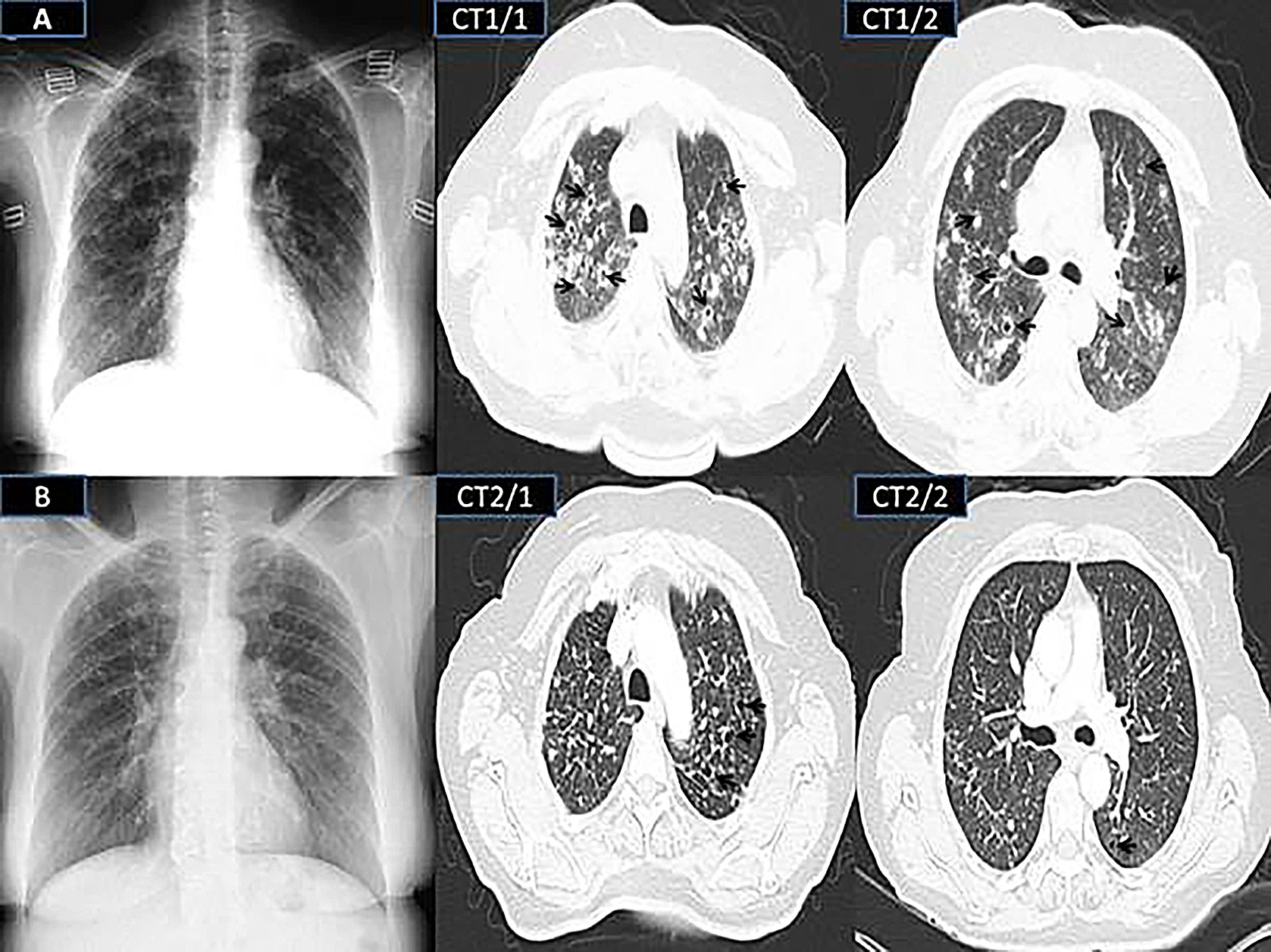Delftia Acidovorans pneumonia with lung cavities formation
Abstract
Case Description: A 52-year-old female patient was admitted to our clinic with complaints of cough, sputum, fever and fatigue. The patient has been receiving immunosuppressive therapy for thrombocytopenic purpura for 5 years.
Clinical Finding: Inspiratory crackles were heard on both hemithorax. Oxygen saturation measured with the pulse oximeter was 97%. Chest X-ray showed diffuse reticular opacities that were more prominent in the upper zones of both lungs. WBC counts were 17600/mm3 and Platelet counts were 29000/mm3. Thorax CT showed that there were many thin-walled cavities and millimetric nodules accompanied by ground-glass infiltrates in the upper and middle lobes. Gram staining of bronchial fluid, taken by bronchoscopy, revealed Gram-negative bacilli and intense polymorphonuclear leukocytes. The bacteria were defined as Delftia acidovorans by BD Phoenix automated system.
Treatment and outcomes: The patient was hospitalized with suspicion of opportunistic pulmonary infections and cavitary lung disease. After the empirical treatment of intravenous piperacillin-tazobactam and oral clarithromycin, her clinical and radiological findings significantly regressed, and she was discharged with outpatient follow-up.
Clinical Relevance: This is the first example of cavitary pneumonia due to Delftia acidovorans in an immunocompromised patient. We would like to emphasize that Delftia pneumonia should be considered in the differential diagnosis of pulmonary cavitary involvement in such patients.
Authors
Downloads
Keywords
- Delftia acidovorans
- gram-negative bacterial infections
- immunocompromised host
- bacterial pneumonia
- respiratory tract infections
- respiratory sounds
- cough
- Piperacillin
- Piperacillin Tazobactam drug combination
- multiple pulmonary nodules
- lung diseases interstitial
References
Schulze H, Gaedicke G. Immune thrombocytopenia in children and adults: what ́s the same, what ́s different? Haematologica. 2011;96(12):1739-41. http://dx.doi.org/10.3324/haematol.2011.055830
Bilgin H, Sarmis A, Tigen E, Soyletir G, Mulazimoglu L. Delftia acidovorans: A rare pathogen in immunocompetent and immunocompromised patients. Canadian J infect Dis Med Microbiol. 2015;26(5):277-9. http://dx.doi.org/10.1155/2015/973284
Khan S, Sistla S, Dhodapkar R, Parija SC. Fatal Delftia acidovorans infection in an immunocompetent patient with empyema. Asian Pacific J Trop Biomed. 2012;2(11):923-4. http://dx.doi.org/10.1016/S2221-1691(12)60254-8
Hagiya H, Murase T, Sugiyama J, Kuroe Y, Nojima H, Naito H, et al. Delftia acidovorans bacteremia caused by bacterial translocation after organophosphorus poisoning in an immunocompetent adult patient. J Infect Chemoth. 2013;19(2):338-41. http://dx.doi.org/10.1007/s10156-012-0472-x
Tas T, Kucukbayrak A, Kocoglu E, Özsoy S, Bucak Ö, Tekelioglu ÜY, et al. Nosocomial pneumonia and bacteremia caused by Delftia acidovorans related to arterial catheter. Dicle Med J. 2012;39(3):3. http://dx.doi.org/10.5798/diclemedj.0921.2012.03.0180.
Weinstein RA, Stamm WE, Kramer L, Corey L. Pressure monitoring devices. Overlooked source of nosocomial infection. JAMA. 1976;236(8):936-8. http://dx.doi.org/ 10.1001/jama.236.8.936.
Yan Y, Meng S, Bian D, Quinn C, Li H, Stratton CW, et al. Comparative evaluation of Bruker Biotyper and BD Phoenix systems for identification of bacterial pathogens associated with urinary tract infections. J Clin Microbiol. 2011;49(11):3936-9. http://dx.doi.org/10.1128/JCM.05363-11.
Donay JL, Mathieu D, Fernandes P, Pregermain C, Bruel P, Wargnier A, et al. Evaluation of the automated phoenix system for potential routine use in the clinical microbiology laboratory. J Clin Microbiol. 2004;42(4):1542-6. http://dx.doi.org/10.1128/jcm.42.4.1542-1546.2004.
Fahr AM, Eigner U, Armbrust M, Caganic A, Dettori G, Chezzi C, et al. Two-center collaborative evaluation of the performance of the BD Phoenix automated microbiology system for identification and antimicrobial susceptibility testing of Enterococcus spp. and Staphylococcus spp. J Clin Microbiol. 2003;41(3):1135-42. http://dx.doi.org/10.1128/JCM.41.3.1135-1142.2003.
Ranc A, Dubourg G, Fournier PE, Raoult D, Fenollar F. Delftia tsuruhatensis, an emergent opportunistic healthcare-associated pathogen. Emerg Infect Dis. 2018;24(3):594-6. http://dx.doi.org/10.3201/eid2403.160939.
Tuddenham WJ. Glossary of terms for thoracic radiology: recommendations of the Nomenclature Committee of the Fleischner Society. AJR Am J Roentgenol. 1984;143(3):509-17. http://dx.doi.org/10.2214/ajr.143.3.509.
LB Gadkowski, JE Stout. Cavitary pulmonary disease. Clin Microbiol Rev, 21: 305-333, 2008. HTTP://DX.DOI.ORG/ http://dx.doi.org/10.1128/CMR.00060-07
Gafoor K, Patel S, Girvin F, Gupta N, Naidich D, Machnicki S, et al. Cavitary lung diseases: a clinical-radiologic algorithmic approach. Chest. 2018;153(6):1443-65. http://dx.doi.org/10.1016/j.chest.2018.02.026.
Ramirez P, Valencia M, Torres A. Bronchoalveolar lavage to diagnose respiratory infections. Semin Respirat Crit Care Med. 2007;28(5):525-33. http://dx.doi.org/10.1055/s-2007-991524.
Sternberg RI, Baughman RP, Dohn MN, First MR. Utility of bronchoalveolar lavage in assessing pneumonia in immunosuppressed renal transplant recipients. Am J Med. 1993;95(4):358-64. http://dx.doi.org/10.1016/0002-9343(93)90303-7.
Kawamura I, Yagi T, Hatakeyama K, Ohkura T, Ohkusu K, Takahashi Y, et al. Recurrent vascular catheter-related bacteremia caused by Delftia acidovorans with different antimicrobial susceptibility profiles. J Infect Chemoth. 2011;17(1):111-3. http://dx.doi.org/10.1007/s10156-010-0089-x.
Lair MI, Bentolila S, Grenet D, Cahen P, Honderlick P. Oerskovia turbata and Comamonas acidovorans bacteremia in a patient with AIDS. European J Clin Microbiol Infect Dis. 1996;15(5):424-6. http://dx.doi.org/10.1007/bf01690106.
Patel D, Iqbal AM, Mubarik A, Vassa N, Godil R, Saad M, et al. Delftia acidovorans: A rare cause of septic pulmonary embolism from catheter-related infection: Case report and literature review. Respirat Med Case Rep. 2019;27:100835. http://dx.doi.org/10.1016/j.rmcr.2019.100835.
Gales AC, Jones RN, Andrade SS, Sader HS. Antimicrobial susceptibility patterns of unusual nonfermentative gram-negative bacilli isolated from Latin America: report from the SENTRY Antimicrobial Surveillance Program (1997-2002). Mem Instituto Oswaldo Cruz. 2005;100(6):571-7. http://dx.doi.org/10.1590/s0074-02762005000600011.
LiPuma JJ, Currie BJ, Peacock SJ, Vandamme PAR. Burkholderia, Stenotrophomonas, Ralstonia, Cupriavidus, Pandoraea, Brevundimonas, Comamonas, Delftia, and Acidovorax. Manual of Clinical Microbiology, 10th Edition: American Society of Microbiology; 2011. http://dx.doi.org/10.1128/9781555817381.ch43

Copyright (c) 2019 Universidad del valle

This work is licensed under a Creative Commons Attribution-NonCommercial 4.0 International License.
The copy rights of the articles published in Colombia Médica belong to the Universidad del Valle. The contents of the articles that appear in the Journal are exclusively the responsibility of the authors and do not necessarily reflect the opinions of the Editorial Committee of the Journal. It is allowed to reproduce the material published in Colombia Médica without prior authorization for non-commercial use

 https://orcid.org/0000-0002-3379-3620
https://orcid.org/0000-0002-3379-3620 https://orcid.org/0000-0001-5922-0348
https://orcid.org/0000-0001-5922-0348 https://orcid.org/0000-0003-3341-9898
https://orcid.org/0000-0003-3341-9898 https://orcid.org/0000-0002-3095-2446
https://orcid.org/0000-0002-3095-2446 https://orcid.org/0000-0003-4077-8549
https://orcid.org/0000-0003-4077-8549 https://orcid.org/0000-0002-8801-7661
https://orcid.org/0000-0002-8801-7661 https://orcid.org/0000-0001-7451-7270
https://orcid.org/0000-0001-7451-7270 https://orcid.org/0000-0003-1999-7827
https://orcid.org/0000-0003-1999-7827


















